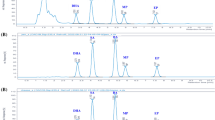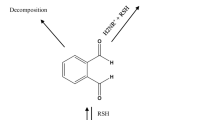Abstract
Steviol glycosides (SGs) are non-caloric, natural sweetener obtained from plant Stevia rebaudiana and are used as sugar substitute in foods. The level of SGs in foods should not exceed maximum permissible limit defined by regulatory agencies. Thus analytical methods are required for assay of stevioside (Stev) and rebaudioside A (Reb A), which are two major constituents of SGs, in foods. A method for extraction of Stev and Reb A from dairy viz., flavoured milk, flavoured yoghurt and non-dairy foods viz., carbonated water, jam, chewing gum and estimation of these by HPLC has been described. Extraction of SGs from dairy samples was achieved by treating samples with 20% acetonitrile in presence of Carrez solutions while these can be simply extracted with water from non-dairy samples. Separation and estimation of these two glycosides was achieved on C18 column (length: 4.6 × 250 mm, particle size: 5 μm) using isocratic mobile phase prepared by mixing of acetonitrile and 10 mM sodium phosphate buffer (pH 2.6) in ratio of 32:68 (v/v). Recovery of two SGs was quantitative. Separation and estimation of SGs by HPLC was robust. Limit of detection and limit of quantitation for Reb A in different food was in range from 1.057–1.834 to 3.525–6.114 mg kg−1 while that of Stev was from 1.679–2.912 to 5.596–9.707 mg kg−1, respectively. Neotame, an artificial sweetener can be used as internal standard for separation of SGs.




Similar content being viewed by others
References
Ahmed MJ, Smith RM (2002) Determination of stevioside by high-performance liquid chromatography with pulsed amperometric detection. J Sep Sci 25:170–172
Amery R, Jooken E, Duquenne B, Geuns J, Meesschaert B (2010) Determination of steviol glycosides in various dairy matrices and soy drink. In: Genus MC (ed). Stevia: science, no fiction. The Proceedings of the 4th EUSTAS Stevia symposium, vol 4, pp 69–82
Aranda-Gonzalez I, Moguel-Ordonez Y, Betancur-Ancona D (2015) Determination of rebaudioside A and stevioside in leaves of S. rebaudiana Bertoni grown in Mexico by a validated HPLC method. Am J Anal Chem 6:878–885
Bartholomees U, Struyf T, Lauwers O, Ceunen S, Geuns JM (2016) Validation of an HPLC method for direct measurement of steviol equivalents in foods. Food Chem 190:270–275
Benford DJ, Hill F, Schlatter J, DiNovi M (2009) Steviol glycosides (addendum). In: Joint FAO/WHO Expert Committee on Food Additives (JECFA) Safety evaluation of certain food additives. Sixty-ninth meeting: food additives, pp 183–219. http://apps.who.int/iris/bitstream/10665/44063/1/9789241660600_eng.pdf. Accessed 8 June 2017
Cardello HMAB, Da Silva MAPA, Damasio MH (1999) Measurement of the relative sweetness of stevia extract, aspartame and cyclamate/saccharin blend as compared to sucrose at different concentrations. Plant Foods Hum Nutr 54:119–129
Chatsudthipong V, Muanprasat C (2009) Stevioside and related compounds: therapeutic benefits beyond sweetness. Pharmacol Ther 121:41–54
Chester K, Tamboli ET, Singh M, Ahmad S (2012) Simultaneous quantification of stevioside and rebaudioside A in different stevia samples collected from the Indian subcontinent. J Pharm Bioallied Sci 4:276–281
Choi YH, Kim I, Yoon KD, Lee SJ, Kim CY, Yoo KP, Kim J (2002) Supercritical fluid extraction and liquid chromatographic-electrospray mass spectrometric analysis of stevioside from Stevia rebaudiana leaves. Chromatographia 55:617–620
De S (1991) Special milks. Outlines of Dairy Technology. Oxford University Press, pp 90–116
EFSA (2010) Scientific opinion on the safety of steviol glycosides for the proposed uses as a food additive. EFSA Panel on Food Additives and Nutrient Sources added to Food (2010). EFSA J 8:1537
EFSA (2015) Scientific opinion on the safety of the proposed amendment of the specifications for steviol glycosides (E 960) as a food additive. EFSA Panel on Food Additives and Nutrient Sources added to Food (2015). EFSA J 13:4316
FSSAI (2012) Minutes of the tenth meeting of food authority (2012), Food Safety Standards Authority of India (FSSAI), New Delhi. http://old.fssai.gov.in/Portals/0/Pdf/minutes_of_authority_meeting%2820-11-2012%29.pdf. Accessed 8 June 2017
Geuns JMC (2003) Stevioside. Phytochemistry 64:913–921
Geuns J, Struyf T, Bartholomees U, Ceunen S (2009) EUSTAS protocol and round-robin testing of steviol glycosides by an internal standard method. In: Proceedings of the 3rd–5th EUSTAS Stevia symposium, vol 9, pp 1–26
Gonzalez C, Tapia M, Perez E, Pallet D, Dornier M (2014) Main properties of steviol glycosides and their potential in the food industry: a review. Fruits 69:127–141
Hearn LK, Subedi PP (2009) Determination levels of steviol glycosides in the leaves of Stevia rebaudiana by near infrared reflectance spectroscopy. J Food Compos Anal 22:165–168
International Conference on Harmonization (ICH), Guideline (2005) Validation of analytical procedures: text and methodology. Q2 (R1), vol 1. Geneva
JECFA—Joint FAO, WHO Expert Committee on Food Additives (2010) Steviol glycosides. Compendium of Food Additive Specifications, Monograph, 10
Jooken E, Amery R, Struyf T, Duquenne B, Geuns J, Meesschaert B (2012) Stability of steviol glycosides in several food matrices. J Agric Food Chem 60:10606–10612
Kochhar A, Dhindsa S, Sachdeva R (2008) Effect of stevia leaf (Stevia rebaudiana) powder supplementation and nutrition counselling on anthropometric parameters and gain in knowledge of the subjects. Ethno-Medicine 2:107–113
Kolb N, Herrera JL, Ferreyra DJ, Uliana RF (2001) Analysis of sweet diterpene glycosides from Stevia rebaudiana: improved HPLC method. J Agric Food Chem 49:4538–4541
Lemus-Mondaca R, Vega-Galvez A, Zura-Bravo L, Ah-Hen K (2012) Stevia rebaudiana Bertoni, source of a high-potency natural sweetener: a comprehensive review on the biochemical, nutritional and functional aspects. Food Chem 132:1121–1132
McQuate RS (2011) Ensuring the safety of sweeteners from Stevia. Food Technol 65:42–49
Minne VJ, Compernolle F, Toppet S, Geuns JM (2004) Steviol quantification at the picomole level by high-performance liquid chromatography. J Agric Food Chem 52:2445–2449
Moussa MM, Zeitoun MM, Zeiton MA, Massoud MI (2003) Physico-chemical properties of stevia sweeteners as natural low coloric sweetener. Alex J Agric Res 48:61–75
Pavlíček V, Tůma P (2017) The use of capillary electrophoresis with contactless conductivity detection for sensitive determination of stevioside and rebaudioside A in foods and beverages. Food Chem 219:193–198
Perez E, Gonzalez C, Vaillant F, Lares M (2016) Stevia derivative and its potential uses in diabetic-directed foods. Review. J Nutr 3:1–20
Pol J, Ostra EV, Karasek P, Roth M, Benesova K, Kotlarikova P, Caslavsky J (2007) Comparison of two different solvents employed for pressurised fluid extraction of stevioside from Stevia rebaudiana: methanol versus water. Anal Bioanal Chem 388:1847–1857
Prakash I, Clos JF, Chaturvedula VSP (2012) Stability of rebaudioside A under acidic conditions and its degradation products. Food Res Int 48:65–75
Sharma R, Rajput YS, Dogra G, Tomar SK (2009) Estimation of sugars in milk by HPLC and its application in detection of adulteration of milk with soymilk. Int J Dairy Technol 62:514–519
USFDA (2016) GRAS Notice (GRN) No. 662. United States Food and Drug Administration. USFDA, Silver Spring. https://www.fda.gov/downloads/Food/IngredientsPackagingLabeling/GRAS/NoticeInventory/ucm519307.pdf. Accessed 8 June 2017
Vanek T, Nepovim A, Valicek P (2001) Determination of stevioside in plant material and fruit teas. J Food Compos Anal 14:383–388
Woelwer-Rieck U, Lankes C, Wawrzun A, Wust M (2010) Improved HPLC method for the evaluation of the major steviol glycosides in leaves of Stevia rebaudiana. Eur Food Res Technol 231:581–588
Yadav SK, Guleria P (2012) Steviol glycosides from Stevia: biosynthesis pathway review and their application in foods and medicine. Crit Rev Food Sci Nutr 52:988–998
Yamamoto S, Tahara S, Sugiki M, Miyakawa H, Uematsu Y, Yamajima Y, Monma K (2016) A rapid dialysis method for analysis of stevioside and rebaudioside A in foods. J Food Hyg Soc Jpn 57:155–159
Yu C, Xu K, Shi Y (2011) The spectrum model established for measuring the contents of Rebaudioside A and Stevioside quickly in the leaves of Stevia rebaudiana Bertoni. Energy Proc 5:855–861
Acknowledgements
The authors would like to thank ICAR-National Dairy Research Institute, India for providing the funding for this research work.
Author information
Authors and Affiliations
Corresponding author
Ethics declarations
Conflict of interest
The authors declare that they have no conflict of interest.
Ethical approval
This article does not contain any studies with human participants or animals performed by any of the authors.
Rights and permissions
About this article
Cite this article
Fayaz, S., Sharma, R., Rajput, Y.S. et al. Estimation of steviol glycosides in food matrices by high performance liquid chromatography. J Food Sci Technol 55, 3325–3334 (2018). https://doi.org/10.1007/s13197-018-3270-3
Revised:
Accepted:
Published:
Issue Date:
DOI: https://doi.org/10.1007/s13197-018-3270-3




